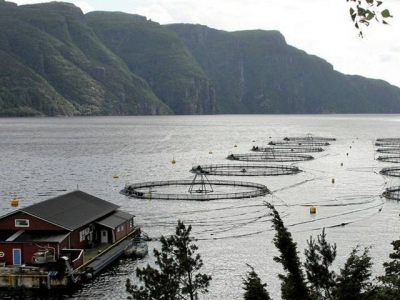Deep pink: fish bone ingredient enhances salmon color

Norwegian scientists make the “unexpected” discovery that the addition of a fish bone mineral hydrolysate to salmon feed can increase pink flesh pigmentation, producing fish that is potentially more attractive to consumers.
Researchers at the Norwegian Institute of Food, Fisheries and Agriculture Research (Nofima), were investigating whether phosphorus hydrolyzed from fish bones could be used as an efficient source of the mineral in salmon feed, when they stumbled upon the discovery that this ingredient appeared to influence astaxanthin uptake.
The color level of the salmon muscle increased considerably – an effect that was visible to the naked eye and was confirmed by chemical analyses, they said.
Astaxanthin is the pigment that lends its distinctive red color to salmon fillets – perceived by consumers as an indicator of quality. Neither salmon nor any other animals can make astaxanthin themselves. In the sea, algae that make astaxanthin are eaten by small crustaceans, which in turn are eaten by fish, such as salmon. In fish farming, a synthetic pigment is added to salmon feed to achieve a red color in fillets.
Only a limited portion – usually less than 10 % – of the astaxanthin in salmon feed is absorbed in the muscle of the farmed salmon. This can be due to limitations in absorption and transport via blood and liver or limited absorption and pigmentation in muscle tissue. Therefore, if uptake of astaxanthin can be increased, this is a positive side effect that has the potential to add to the market value of this fish.
Initial discovery
In the initial experiment with smaller salmon, it was found that the astaxanthin levels in blood, liver and whole fish were 55, 29 and 22 per cent higher respectively, compared with fish that were fed an ordinary source of commercial phosphorus.
Sissel Albrektsen, lead author and senior scientist at Nofima, told FeedNavigator the aim of this latest trial was to confirm these findings in larger fish.
“The trial was targeted to understand the impacts of astaxanthin utilization,” she explained. “In the previous trials on smolt, we just observed that as well as acting as a mineral supplement, the mineral-rich fish bone ingredients appeared to have additional effects on astaxanthin.”
Feed with the phosphorus-rich mineral ingredient was tested on salmon during the growth period from 1.7 to 2.5kg. Fish were reared in 12 net-pens and fed with one of four formulated diets for 78 days.
The control diet (D1) used CaPO4 as the phosphorus source, whereas diets D2 and D3 were supplemented with a fish bone hydrolysate at a dose of 2.1% and 4.2% respectively. Diet D2 was also further balanced with CaPO4.
Higher astaxanthin retention
Retention of astaxanthin in the muscle (which translates to a redder color) was found to be 35% higher in fish on the D3 diet. The researchers believe this is because the salmon digest more of the astaxanthin with the mineral ingredient present in the feed.
“The results suggest that the increased astaxanthin utilization in the fish was explained by slightly improved astaxanthin digestibility, possibly combined with lower metabolic loss of astaxanthin,” wrote the researchers.
They added that confirmation of the physiological impacts of the fish bone compounds on flesh quality and texture would be needed to claim such properties.
Source: Aquaculture
Authors: Albrektsen S, Østbye T.-K, Pedersen M, Ytteborg E, Ruyter B, Ytrestøy lT
Related news
 Vietnam no longer exclusive exporter of tra fish
Vietnam no longer exclusive exporter of tra fish Vietnam will no longer dominate the global tra fish market as many other countries have taken to tra fish processing and export in direct competition
 Experts discuss global shrimp demand, VN’s supply capacity
Experts discuss global shrimp demand, VN’s supply capacity Việt Nam’s supply capacity to 2025 to fulfill global shrimp demand is sufficient but the industry still faces challenges, speakers said at a conference held on
 Vietnam looks to develop new markets for tra fish
Vietnam looks to develop new markets for tra fish Vietnam’s tra fish is facing many challenges in terms of market development, especially in light of the current U.S.-China trade war, a VietnamPlus news report